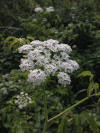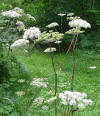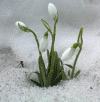 The
Wild Foodies of Philly
The
Wild Foodies of Philly
In
search of the food beneath our feet!
POISONOUS PLANTS - ALL PARTS
The Wild Foodies of Philly
In search of the food beneath our feet!
POISONOUS PLANTS - ALL PARTS
|
POISON IVY VINE
all parts
& the smoke from burning them
|
POISON OAK VINE
–
all parts & the smoke from burning them http://en.wikipedia.org/wiki/Toxicodendron_diversilobum …causes itching; then evolves into dermatitis with inflammation, colorless bumps, severe itching, and blistering… leafless branches and twigs contact also causes allergic reactions…extremely hazardous, from wildfires, controlled burns, or disposal fires. The smoke can poison people … Branches used to toast food over campfires can cause reactions internally and externally |
|
http://www.wildmanstevebrill.com/Plants.Folder/False%20Hellebore.html
|
https://backyardsafari.wordpress.com/2010/04/26/lessons-from-an-edible-plant/
The
plant contains calcium oxalate crystals
as raphides in
all parts, and because of this consumption of the raw plant material
results in a powerful burning sensation. It can cause irritation of the
mouth and digestive system, and on rare occasions the swelling of the
mouth and throat may be severe enough to affect breathing.If the plant is
properly dried or cooked it can be eaten as a root vegetable. A
preparation of the root was reported to have been used by Native
Americans as
a treatment for sore eyes. Preparations were also made to treat rheumatism, bronchitis,
and snakebites, as well as to induce sterility.
|
|
NIGHTSHADE / HORSE NETTLE
- all parts toxic
|
http://en.wikipedia.org/wiki/Solanum_dulcamara The fruit is an ovoid red berry about 1 cm long, soft and juicy, with the aspect and odor of a tiny tomato, and edible for some birds, which disperse the seeds widely. However, the berry is poisonous to humans and livestock, and the berry's attractive and familiar look make it dangerous for children. |
|
CANADIAN MOONSEED
– all parts toxic, no tendrils as with edible grapevines, half-moon
seeds, unlike round grape seeds http://en.wikipedia.org/wiki/Menispermum_canadense All parts of these plants are known to be poisonous. The principal toxin is the alkaloid dauricine. The fruit of Canada Moonseed are poisonous and can be fatal. |
POISON SUMAC – all parts irritant to skin (edible cousin – Staghorn Sumac) white flowers in spring, white berries in fall
http://en.wikipedia.org/wiki/Toxicodendron_vernix
All parts of the plant contain a resin called
urushiol
that causes skin and mucous membrane irritation to humans. When burned,
inhalation of the smoke may cause the rash to appear on the lining of the
lungs, causing extreme pain and possibly fatal respiratory difficulty.
http://www.wildwoodsurvival.com/survival/food/poisonousplants/poisonsumac |
|
DOGBANE
– all
parts toxic, except perhaps seeds (see below), looks like milkweed, but
woody & multi-stemmed http://en.wikipedia.org/wiki/Apocynum_cannabinum All parts of the plant are poisonous and can cause cardiac arrest if ingested. |
GREATER CELENDINE
- all
parts toxic, orange-yellow latex sap http://www.botanical-online.com/english/celandine_poisonous.htm Yes, celandine is a toxic plant. It contains a corrosive caustic juice, and it is rich in toxic alkaloids. Its medicinal use must be carefully controlled . It is Not recommended for internal use. |
|
JIMSON WEED/ THORN APPLE
-
all parts toxic
|
YEW BUSH / TREE – http://www.wildfoodies.org/Yew.htm - Most parts toxic, except red sweet flesh that surrounds its highly toxic black seed
|
|
POISON HEMLOCK-
KNOW THIS PLANT! All parts highly toxic.
|
WATER HEMLOCK
KNOW THIS PLANT! All
parts highly toxic.  http://en.wikipedia.org/wiki/Cicuta
...Upon
consumption, both in humans and other species, the symptoms of poisoning
are mainly characterized by generalized seizures. The onset of symptoms
following ingestion may be as soon as 15 minutes post ingestion. Initial
symptoms reported may include nausea, vomiting, abdominal pain, tremors,
confusion, weakness, dizziness, and drowsiness;although the rapid onset of
seizure activity may be the first sign presented following poisoning. http://en.wikipedia.org/wiki/Cicuta
...Upon
consumption, both in humans and other species, the symptoms of poisoning
are mainly characterized by generalized seizures. The onset of symptoms
following ingestion may be as soon as 15 minutes post ingestion. Initial
symptoms reported may include nausea, vomiting, abdominal pain, tremors,
confusion, weakness, dizziness, and drowsiness;although the rapid onset of
seizure activity may be the first sign presented following poisoning. |
|
GIANT HOGWEED, GIANT COW PARSNIP
– highly toxic http://en.wikipedia.org/wiki/Heracleum_mantegazzianum - The sap of giant hogweed causes phytophotodermatitis in humans, resulting in blisters, long-lasting scars, and—if it comes in contact with eyes—blindness. These serious reactions are due to the furocoumarin derivatives in the leaves, roots, stems, flowers, and seeds of the plant.
|
HORSE CHESTNUT TREE
– all parts toxic, looks like Chestnut
|
|
MISTLETOE
– all parts
toxic, grows in trees, visible in winter
http://www.hiltonpond.org/thisweek051208.html |
SNOWDROP  https://pfaf.org/user/Plant.aspx?LatinName=Galanthus+nivalis https://pfaf.org/user/Plant.aspx?LatinName=Galanthus+nivalis
|